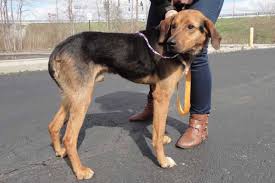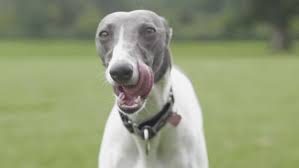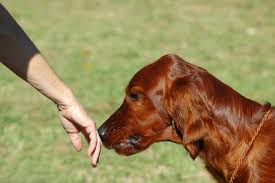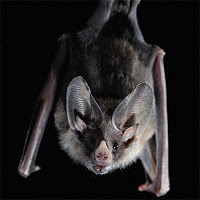Why Is Understanding Our Dog's Body language So Vital?
Debbie Martin, Fear Free
 Licensed Veterinary Tech and Certified Professional Dog Trainer Debbie Martin is here to help us decode our pet's body language. She knows just about everything about dog behavior and how to read your own dog's body language and states there are some common signs of distress or anxiety that people miss. This is part of our Fear Free Expert Series.
Licensed Veterinary Tech and Certified Professional Dog Trainer Debbie Martin is here to help us decode our pet's body language. She knows just about everything about dog behavior and how to read your own dog's body language and states there are some common signs of distress or anxiety that people miss. This is part of our Fear Free Expert Series.
Many people are oblivious to actually understanding what our pets are saying with their behavior. Animals can't just yap out when they're feeling hungry or upset, but they do show it with their bodies. Unfortunately most of us don't know how to interpret that.
Why is it important to understand your pet's body language?
Debbie explains that its really important that owners can read their pet's body language, whether it be a dog or a cat, because its their main mode of communication to humans. Animals communicate in a variety of different ways through vocalizations as well as smell or scent within their species. But their main mode of communication for people is really going to be body language. These are things that we can pick up on as pet parents and advocates for our pets so we can recognize when they're feeling relaxed and happy about something or when they might be a little bit nervous or anxious.
 What are some common signs of distress and anxiety?
What are some common signs of distress and anxiety?
There are obvious signs that are going to happen when an animal is trying to get away from a situation. It could be that their tails are tucked really tight underneath them, they're frozen with fear, they're trembling or their ears are back. Those are very obvious signs that animal is distressed or nervous or anxious, but there can be very subtle signs that lead up to that as well. It's important that we're aware of these signs so that we can perhaps change the environment or the interaction that's happening so our animal doesn't become overly distressed.
Some of the subtle signs are things like licking their lips, avoiding eye contact, maybe turning their head away or moving away slightly. It could be panting when they're not hot or being active. Sometimes we'll see dogs do things like the "wet dog shake" when they are playing roughly with another dog. They may all of a sudden stop and shake off even though they're not wet. This is kind of a stress reliever for them. So these can be kind of subtle things that are happening that could just say our dogs a little bit nervous or anxious or it could be higher arousal.
What's really important to realize is that body language tells part of the story. But the other part is context. Looking at the context of when it's happening. So for example, if a stranger approaches your dog and the dog looks away, licks his lips and maybe does a wet dog shake and starts to turn away from that person, your dog is probably saying, "Hey I'm not quite comfortable interacting with this person right now." And we shouldn't force the issue.
 So does a wagging tail always mean that a dog is happy and approachable?
So does a wagging tail always mean that a dog is happy and approachable?
Not always. It depends how the tail wags, according to Debbie. Then again there is the context. Is it in the natural position that that dog will carry its tail? This can get tricky because dog tails come in a variety different shapes and sizes and carriage. Some dogs carry them naturally really high over their back and some don't even have tails, which make it even more challenging. But others are going to have just kind of normal tail carriage.
You need to be able to recognize your own dog's body language, like where their tail is when you come home and they're happy to see you. What does that look like? It should be kind of wag back and forth. That's a fairly neutral position and its not way up high over their back, unless that's how your dog normally carries their tail. There are breeds of dogs that their tails curl up over their back and so it doesn't always apply depending on the breed or the combination of breeds that your dog has within them.
There is one thing that Debbie always sees people do that she wishes they would stop. She states that there's this misconception that we need to put our hand out for a strange dog to smell us so that they can kind of get to know us. However, dogs can smell us from a mile away. A dog can smell a human fingerprint on a pane of glass six weeks later. You don't need to put your hand out!
 When you put your hand out, in dog language that is getting into their personal space maybe before they're ready. Debbie's biggest tip for people is to play hard to get even with dogs that seem interested in you. Act very nonchalant. Avoid eye contact. Turn sideways and let them approach you on their own terms instead of trying to be their friend right away. Because even the most well intentioned friendly person can put a dog off very quickly by getting into their face and trying to be their best friend immediately.
When you put your hand out, in dog language that is getting into their personal space maybe before they're ready. Debbie's biggest tip for people is to play hard to get even with dogs that seem interested in you. Act very nonchalant. Avoid eye contact. Turn sideways and let them approach you on their own terms instead of trying to be their friend right away. Because even the most well intentioned friendly person can put a dog off very quickly by getting into their face and trying to be their best friend immediately.
Just think if you were out walking and someone said hello to you. You would probably say it back and that would be fine. But if they ran up right into your face and tried to give you a little hug, you would be pretty overwhelmed. It's no different with dogs.
Check out the websites Fear Free Happy Homes and Fear Free Pets.
Listen and Explore the Fear Free Expert Series
Vegas Bats Positive for Rabies - What's the Risk? - Dr. Debbie
 Think your pet doesn't need a rabies vaccine because it lives indoors? Think again. Bats have been known to fly through open windows or chimneys. Dogs and cats that go outdoors are at risk for rabies exposure through wildlife. Felines that hunt and bring "presents" have added rabies risk.
Think your pet doesn't need a rabies vaccine because it lives indoors? Think again. Bats have been known to fly through open windows or chimneys. Dogs and cats that go outdoors are at risk for rabies exposure through wildlife. Felines that hunt and bring "presents" have added rabies risk.
Common questions about rabies:
What is Rabies?
Rabies is a viral disease causing encephalitis (brain inflammation) that affects all mammals including humans. The disease is almost always fatal. Over 59,000 people worldwide die of rabies every year, but fortunately U.S. human deaths are rare with 1 to 2 reported per year. Pet and farm animal rabies cases do occur in the U.S. though, usually after tangling with wildlife.
How is Rabies Passed?
Rabies is passed in saliva through the bite of a rabid animal. Less common exposures to rabies include aerosol transmission, mucous membrane contact or rare cases of organ transplant in humans.
What Are Symptoms of Rabies?
Excessive drooling, aggression, staggering and seizures are symptoms of rabies in animals. Wild carnivores, like coyotes, that avoid people are suspect if lacking fear and approaching humans. Nocturnal species like bats that are found out during daylight are also suspect for rabies.
What Kind of Animals Carry Rabies?
Although pet and human rabies cases in the U.S. are rare, the infection still abounds in wildlife reservoirs. In the Las Vegas area, bats are most commonly carriers, but other wildlife carriers include raccoons, skunks and foxes.
What Do You Do If You See a Sick or Dying Bat?
Avoid contact with sick or dying bats. Do not take sick bats to the veterinarian. Call Animal Control if any human or pet exposure to sick bat.
Despite the rabies concern, bats do have an important role in our ecosystem by consuming insects and pollinating plants. Not every bat has rabies, and there are other reasons bats die.
What Do I Do If a Person or Pet is Scratched or Bitten By a Bat or Other Wildlife?
If your pet gets into a fight with a skunk or raccoon, or plays with a dying or dead bat, there is potential for rabies exposure and a report should be made. Call animal control to have the bat or other wildlife picked up.
 Possible rabies exposure is evaluated on a case-by-case basis. Because rabies is fatal, any humans with suspect rabies exposure should make a report to the local health department. Fortunately post exposure treatment for people is very effective in preventing disease, and doesn't involve painful stomach injections reported of long ago.
Possible rabies exposure is evaluated on a case-by-case basis. Because rabies is fatal, any humans with suspect rabies exposure should make a report to the local health department. Fortunately post exposure treatment for people is very effective in preventing disease, and doesn't involve painful stomach injections reported of long ago.
What Happens to Pets After Exposure to Suspected or Known Rabies?
Ultimately local rabies ordinances dictate how each case is handled. Pets with current or late rabies vaccinations may be quarantined for 10 days.
A pet that never has had a rabies vaccine may be promptly euthanized and tested for rabies. In other cases of unvaccinated pets, extended quarantine periods up to 6 months may arise.
What Can I Do to Protect My Pets and Family From Rabies?
- Vaccinate animals for rabies - this includes dogs, cats, ferrets and select farm animals.
- Teach children never to handle bats.
- Do not keep wild animals as pets.
- Spay and neuter your pets to decrease the desire to roam.
- Maintain control of your pets when outdoors or hiking to avoid accidental exposure to wildlife.
- Bat-proof your home and garage to avoid nesting sites and close encounters with bats.
- Report human bites from pets or wildlife to public health and animal control authorities.
Vaccination is key to protecting pets from rabies and offers peace of mind to pet owners and the Rabies vaccine is typically inexpensive.
Rabies vaccination...Just do it!
Featured veterinarian known as "Dr. Debbie" on national pet radio program, Animal Radio. Ebook author of "Yorkshire Terriers: How to Be Your Dog's Best Friend"; "Pugs: How to Be Your Dog's Best Friend"; "Mini Schnauzers: How to Be Your Dog's Best Friend"; and "Shih Tzu: How to Be Your Dog's Best Friend." Dr. Debbie's books.
Visit Website
Animal Radio News - Lori Brooks
Keep Your Pets Away From Your Pot
If you or you know anyone who uses marijuana, you have to store it in a safe place where pets can't get to it. There's a study out of Colorado that shows a four-fold increase in pet cannabis-related medical cases and much of that is a simply pet getting into their owners' stash. Answer.com (a web site that allows people to chat online with experts) says that the number of questions it has received related to marijuana and pets has gone up by 65-percent. In reviewing their calls, Ask.com said most of the requests for information asked about what to do if a dog or cat had consumed marijuana, with most of those cases involving dogs. There's a chemical naturally in marijuana called THC (it's what gives users the high) that is toxic to pets. Veterinary experts say that cannabis can damage the neurological system in pets and can sometimes be fatal. They fear they are just seeing the start of the problems. But not all of these pet overdose cases are accidental ingestion. They're starting to see an increase in cannabis intoxications due to pet parents using 'low THC' cannabinoid or CBD products. The market is booming for so-called "pot for pets" products, many made from hemp, because it contains only minute traces of THC and purportedly can treat certain pet ailments. These products boast of the benefits of CBD (cannabidiol), a cannabis compound that doesn't include any of the intoxicating qualities. There's big difference and if you're not familiar with cannabis and all of it's components, have a talk with your vet before giving any pot pet products to your fur babies. Finally, experts warn about the poop of humans who eat cannabis foods and deserts, because dogs have been known to eat human poop. Just so you know, consumed cannabis is not metabolized in humans as it passes through the digestive system and is expelled in the feces. If a dog eats that poop, it's the same as them ingesting it. Also, many of the marijuana desserts and sweets are made using xylitol and artificial sweeter which is extremely toxic to dogs.
 You Can Get Pneumonia from Guinea Pigs
You Can Get Pneumonia from Guinea Pigs
There's a discovery that can affect the world of guinea pig lovers. Dutch researchers say the cute furry rodents may carry germs tied to a very serious type of pneumonia. It's caused by the same bacteria the causes pink eye in guinea pigs and three people in the Netherlands have wound up hospitalized for pneumonia after contact with guinea pigs. Two of the three patients had to be put on a ventilator in intensive care units, or ICUs, although all three survived following treatment with antibiotics. Experts say it was not previously known that the bacteria could infect humans. Not all guinea pigs carry this bacterium, but many likely do. An earlier study found the bacteria's DNA in 59 out of 123 guinea pigs with eye disease and pink eye. Whether your guinea pig has pink eye or not, it's very important that you practice good personal and pet hygiene and wash your hands every time after handling the pet just in case your guinea has that bacteria. And never let anyone who is immune compromised or very young children handle guineas with eye infections.
 Missing Cat Is Reunited With Family After 10 Years
Missing Cat Is Reunited With Family After 10 Years
Pets seem to go missing all the time, but it's not every day that they are reunited with their families. Jack the cat and his family were incredibly lucky! Ten years ago Jack went missing but because Jack had been micro-chipped as a kitten the Sanctuary where Jack eventually ended up was able to find his family after all that time.
 Listen to the entire Podcast of this show (#1144)
Listen to the entire Podcast of this show (#1144)





